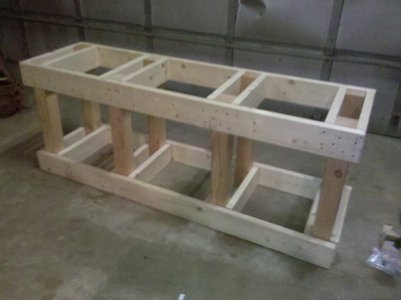Obviously, the size of the lathe matters, in my case it's a PM 1127VF-LB. About 600lbs. The manual lists the footprint at 56x26 inches. I would like to include extra space on the sides to use as a general workbench for lathe related operations. I was thinking of mounting a vise and such, but I wonder if hammering on things near the lathe is not such a good idea. I think I'll move that elsewhere. So perhaps 6x3ft?
My initial thinking is to base the design off the stands people build for large aquariums. They are able to hold thousands of pounds of water, and thousands of dollars in livestock. They also have to maintain level, and can't sag or the tank cracks. The basic idea is to keep all the weight on wood, no screws in shear bearing weight etc..

I'm open to suggestions. This concept just seemed simple enough and very sturdy.
The shop floor is poured concrete, not the most level. I'm considering using leveling feet in the posts, perhaps an extra one in the middle on one end to make a triangle leveling setup. Level that way, then run the other feet down for stability. I know the lathe doesn't need to be leveled to the horizon, but it's nice if the parts don't want to roll of the bench too. And if the bench is at least close, the machinist level has a chance of not being pegged to one side when leveling the lathe.
Looking at the lathe and various posts here about benches and leveling, it looks like the weight is mostly in 2 places along the length. The lathe feet. So it makes some sense to build the center posts on that distance to accommodate that, with a board across the posts to mount the lathe to. Perhaps with some form of leveling adjuster under the lathe. I think it was Mikey that posted a pic of some Enco leveling adjusters that looked easy to make that would work well. Then similar boards for the table top to mount to at the ends. Perhaps cut the center posts 4" short and run a piece of 4x4 between them.
I'm 6'4", so I would want it high enough that I'm not leaning over the machine all the time. It would help if I knew the base to center height of the lathe, perhaps someone would measure theirs? I can ask PM as well. Perhaps 3-4ft posts, then 1-2" for the table top. It might be easier to build or buy an adjustable stool though..
I figure I can add shelves/drawers in the bench as well to hold tooling.
My initial thinking is to base the design off the stands people build for large aquariums. They are able to hold thousands of pounds of water, and thousands of dollars in livestock. They also have to maintain level, and can't sag or the tank cracks. The basic idea is to keep all the weight on wood, no screws in shear bearing weight etc..

I'm open to suggestions. This concept just seemed simple enough and very sturdy.
The shop floor is poured concrete, not the most level. I'm considering using leveling feet in the posts, perhaps an extra one in the middle on one end to make a triangle leveling setup. Level that way, then run the other feet down for stability. I know the lathe doesn't need to be leveled to the horizon, but it's nice if the parts don't want to roll of the bench too. And if the bench is at least close, the machinist level has a chance of not being pegged to one side when leveling the lathe.
Looking at the lathe and various posts here about benches and leveling, it looks like the weight is mostly in 2 places along the length. The lathe feet. So it makes some sense to build the center posts on that distance to accommodate that, with a board across the posts to mount the lathe to. Perhaps with some form of leveling adjuster under the lathe. I think it was Mikey that posted a pic of some Enco leveling adjusters that looked easy to make that would work well. Then similar boards for the table top to mount to at the ends. Perhaps cut the center posts 4" short and run a piece of 4x4 between them.
I'm 6'4", so I would want it high enough that I'm not leaning over the machine all the time. It would help if I knew the base to center height of the lathe, perhaps someone would measure theirs? I can ask PM as well. Perhaps 3-4ft posts, then 1-2" for the table top. It might be easier to build or buy an adjustable stool though..
I figure I can add shelves/drawers in the bench as well to hold tooling.
